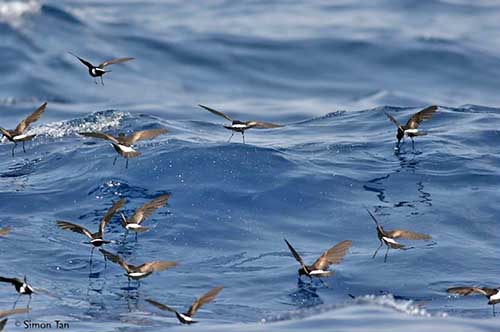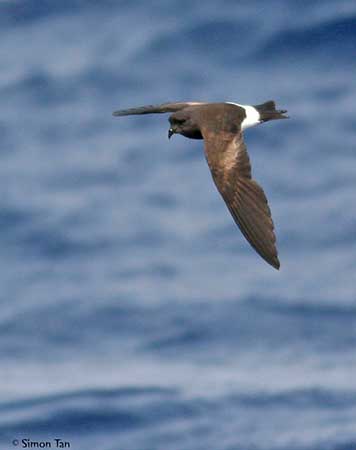
Fr: Océanite de Wilson
Ang: Wilson’s Storm-Petrel
All: Buntfuß-Sturmschwalbe
Esp: Paíño de Wilson
Ita: Uccello delle tempeste di Wilson
Nd: Wilsons Stormvogeltje
Sd: Havslöpare
Photographer:
Simon Tan
PBase Bird galleries
Text by Nicole Bouglouan
Sources:
HANDBOOK OF THE BIRDS OF THE WORLD vol 1 by Josep del Hoyo-Andrew Elliot-Jordi Sargatal - Lynx Edicions - ISBN: 8487334105
A Complete Guide to Antarctic Wildlife by Hadoram Shirihai and Illustrated by Brett Jarrett - Edited by Guy M. Kirwan - ALUL.A Press Oy, Finland - ISBN 9519894705
BirdLife International (BirdLife International)
Department of Sustainability, Environment, Water, Population and Communities
New Zealand birds and birding (Narena Olliver)
Neotropical Birds – Cornell Lab of Ornithology
What Bird-The ultimate Bird Guide (Mitchell Waite)
Wikipedia, the free encyclopaedia
Wilson’s Storm-Petrel
Oceanites oceanicus
Procellariiformes Order – Oceanitidae Family
INTRODUCTION:
The Wilson’s Storm-Petrel is now included in the southern subfamily Oceanitidae, but it is a transequatorial migrant that winters in the northern hemisphere.
This species has wide range and large populations. However, the main threats are first the ingestion of plastic, and then, the fishing nets where birds can be entangled at sea. It also has some natural avian predators on the breeding islands.
The Wilson’s Storm-Petrel spends most of the year at sea and comes on land only for breeding.

DESCRIPTION OF THE BIRD:
Biometrics:
Length: 18 cm
Wingspan: 38-42 cm
Weight: 35 g
The adult has sooty-brown head and upperparts with darker flight feathers. There is a greyish panel on the inner art of the upperwing, formed by the paler greater coverts. The white rump contrasts strongly with the blackish tail.
The underparts are sooty-black too, except the white sides of tail’s base and the thighs. Underwing and undertail are blackish.
The bill is black. The eyes are dark brown. Legs and feet are black with yellow webs bordered with black.
Both adults are similar in plumage, but the female is slightly larger with longer wings.
The juvenile resembles adult but it often shows some white feathers on belly.
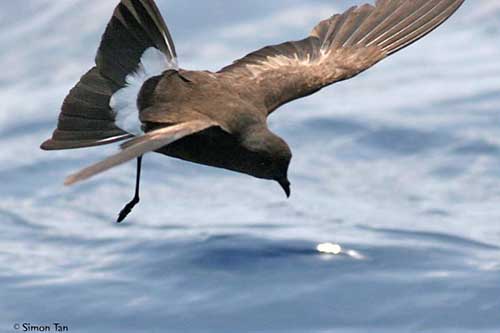

SUBSPECIES AND RANGE:
The Wilson’s Storm-Petrel has three recognized subspecies.
O.o. chilensis breeds in Tierra del Fuego. Outside this period, it can be found at least as far as Peru.
O.o. oceanicus is present in all major oceans. It breeds on subantarctic islands from Cape Horn E to Kerguelen and Heard islands.
O.o. exasperatus is also present in all major oceans. It breeds on South Sandwich Islands, the islands of Scotia Sea and coastal Antarctica. This one is the largest race.
HABITAT:
The Wilson’s Storm-Petrel is strictly marine. During the breeding season, it frequents the cold waters inshore or over the continental shelf. Outside this period, it is mainly over pelagic waters.
The breeding colonies are established on remote, rocky islands, usually on cliffs or among boulder scree. Although it avoids snow and ice, there are some records of birds nesting up to 120 kilometres inland in E Antarctica, at 600 metres of elevation.
It nests in rock crevices and self-excavated burrows under boulders.
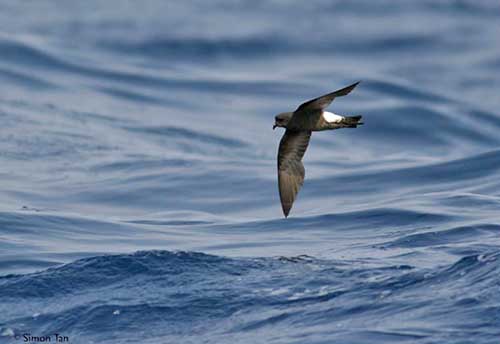
CALLS AND SONGS: SOUNDS BY XENO-CANTO
The Wilson’s Storm-Petrel’s main call is a loud, nasal, grating « aark aark » given from the ground at colonies. The male utters a monotonous chatter to attract females “aark-uh-ah-ah-uh-uh”.
This species is usually silent at sea, but some quiet, low squeaks can be heard within the feeding flocks.
The birds may call during aerial pursuits or while flying above the nesting hole at night.
BEHAVIOUR IN THE WILD:
The Wilson’s Storm-Petrel feeds mainly on crustaceans, especially krill of genus Euphausia, small fish (2-8 cm long), squid and carrion. It also follows ships and trawlers for offal, and often feeds around large cetaceans that lead the preys to the surface.
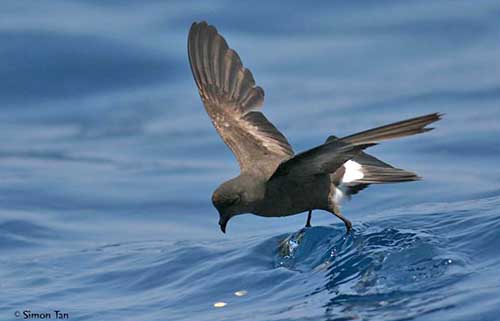
The Wilson’s Storm-Petrel feeds by “running” over the surface. It flies low over the water with dangling legs and outstretched wings. The bill (or the entire head) is submerged in the water to seize the food. The birds patter on the water surface with their feet, displaying conspicuously the yellow webs, in order to disturb the preys and to attract them to the surface. Dipping, pattering, skimming and shallow-plunging are the usual techniques.
They are very gregarious and forage in flocks.
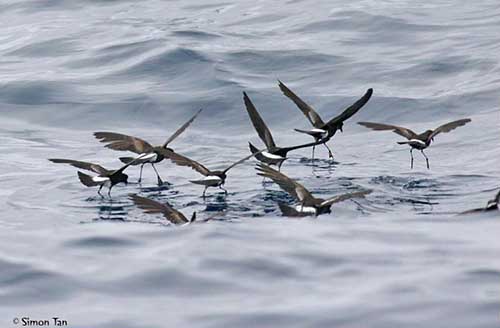
The Wilson’s Storm-Petrel returns to the colonies in November/December. They are monogamous, usually with long-term pair-bonds retained from year to year.
The nuptial displays include aerial pursuits at night. Two or several birds fly fast in circles above the nesting site while calling loudly. It is suggested that the conspicuous white rump is helpful in these displays performed in almost total darkness.
The female performs a pre-laying exodus during 10-11 days prior to the egg-laying. They are loosely colonial and may share the site with other seabird species.
The Wilson’s Storm-Petrel is a transequatorial migrant. It migrates from the breeding grounds in Antarctic to N of the Equator in Atlantic, Indian and Pacific Oceans. A few birds migrate N into E Pacific Ocean. The non-breeding birds may remain in the north throughout the year.
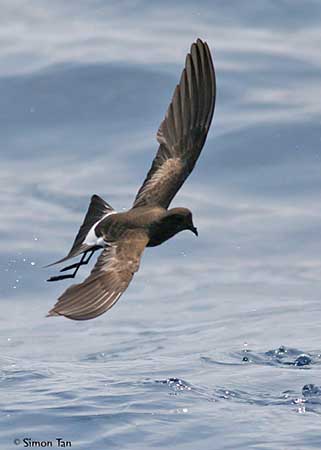
This species is an agile but restless flier. The flight can be buoyant and erratic. It flies low over water, gliding slowly with wings at body-level or held in shallow V shape. The legs are dangling and dipping in the water, and the bird moves by “walking” and “hopping” on the water surface. Even on the roughest seas, it flies in the troughs of waves during the strong winds.
It also swims very well but it is very feeble and clumsy on the ground.
REPRODUCTION OF THIS SPECIES:
The breeding season occurs between November/December and late January/late March throughout the range.
The Wilson’s Storm-Petrel breeds in loose colonies established on rocky islands, on cliffs or among boulder scree. It nests in cavities, rock crevices or burrows (20-50 cm long). The nest can be unlined, but sometimes, the nest-chamber is lined with feathers and moss.
The female lays a single white egg. Both adults share the incubation during about 43 days (between 38 and 59 days), in stints of two days. At hatching, the chick has grey down overall. It is brooded for 1-2 days. It is fed at night by both parents and fledges about 60 days after hatching.
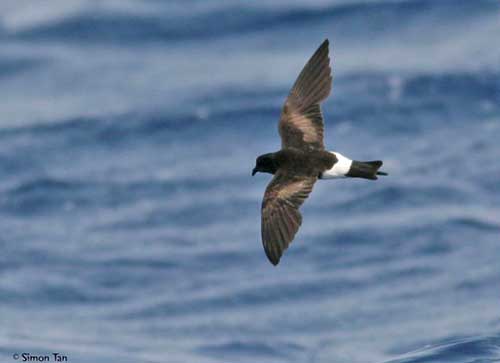
Adults, chicks and eggs are preyed upon by skuas, Sheathbills and Kelp Gulls, but also by rats and cats on some breeding islands such as Crozet and Kerguelen.
The adults are mostly taken and killed by Great Skuas from ground or in flight. But at South Georgia, they can be killed by Southern Giant Petrels and Northern Giant Petrels.
PROTECTION / THREATS / STATUS:
In spite of predation on the breeding grounds, the Wilson’s Storm-Petrel is one of the most abundant of all seabirds.
The population was estimated at 12,000,000/30,000,000 individuals in 2004, and it is still suspected to be stable.
The Wilson’s Storm-Petrel is currently evaluated as Least Concern.
